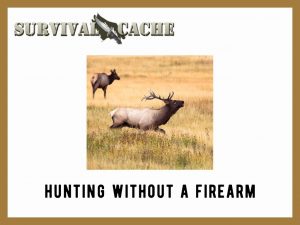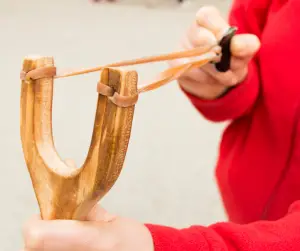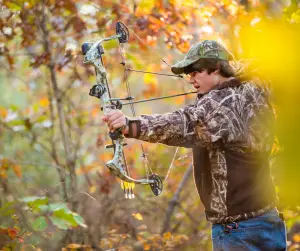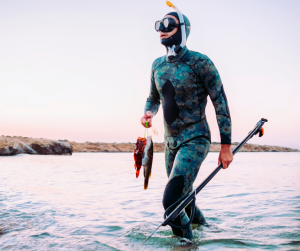Hunting in modern times always conjures up an image of a person with a firearm. But when considering human history, the firearm is a fairly recent invention.
It may come as a shock to many people that hunting can be done without firearms, but for much of human history, hunting has been conducted without the use of gunpowder and a bullet.
If you find yourself without a firearm in a survival situation, there are many ways that food can be hunted or fished. What those methods are and how they work is the focus of today’s article.
SKIP AHEAD
Hunting Without a Firearm
Disclaimer: note that the following ideas are for informational use only and it is up to the responsibility of the reader to check their local hunting laws. Many of the methods/tools discussed may be illegal in your area when they used outside of a life and death survival situation.
Slingshot
A slingshot is a simple device that consists of a forked device with two elastic bands and a pouch. When a projectile is placed in the pouch, pulled back, and released, it is propelled through the air towards a target.
These tools are most effective when used against smaller game animals like rabbits, birds, or squirrels but depending on the slingshot’s setup, they can take out the larger game.
Modern slingshots are no joke and should no longer be thought of as children’s toys. Depending on the ammunition and bands used, they are certainly deadly tools. They are incredibly quiet and when used in the right hands are an effective means of acquiring game at short to medium ranges.
Rock Slings
Rock slings have been used longer than slingshots. They are a little more difficult to use and require a lot of practice. The sling consists of a pouch with two cords attached.
A rock is placed in the pouch and it is then swung around quickly in a circular motion. When one of the cords is released, the rock is launched towards the intended target.
Rabbit Stick
The rabbit stick is about as basic as it gets and has been used throughout human history as a hunting tool for acquiring small game animals.
It somewhat resembles a boomerang but a rabbit stick will not fly back to you after it is thrown.
The best design for a rabbit stick is one that is slightly curved and club-shaped. This means that one end of the wood will be thicker or heavier than the handle portion.
Once a piece of wood is crafted, try to practice throwing this tool at a dead stump to hone your aim. Once dialed in, you will be amazed at how effective it is at stunning rabbits, squirrels, birds, and other small critters.
It may take a little bit of time to find the right piece of wood and a little bit of carving, but a rabbit stick is extremely simple to make, use, and as long as it is not lost it is a tool that can be over and over.
Snares
The use of snares is a great alternative to using firearms. Cordage may be available in your pack or can be made from natural materials if you know what plants or trees to harvest it from.
A snare is a simple and effective trap that utilizes a looped piece of cordage for ensnaring an animal. This method can either “end an animal” or be set up as a live trap.
The most common types are a simple snare and a spring snare. A spring snare can also be utilized for catching fish which gives more options in food procurement.
Here’s a detailed video on the same.
Bow and Arrow
This is an age-old weapon that predates firearms and is an extremely effective hunting tool.
Quite simply it is a bow and string that propels an arrow with a point. Historically there are many different types of points placed on the end of an arrow but a broadhead or spear point seems to be the most commonly used and easiest to make.
Nowadays there are options when it comes to bow designs. Some of them are take down survival bows, compound bows, crossbows, recurve, and long bows.
However, with the right materials, tools, time, and a little know how, this weapon can be made from all-natural materials.
A bow and arrow can be used in the acquisition of land animals or aquatic life, which broadens the options of where food can be gathered.
No matter which design you use, a bow and arrow gives range and power when hunting small, medium, or large animals.
Pitfalls
In its simplest form, a pitfall is a hole dug into the ground with a camouflage layer covering the top. When an animal walks across the top layer of vegetation, it falls and becomes trapped inside.
A simple pitfall can be used for trapping animals alive which can prolong the longevity of the meal.
A spiked pitfall uses pieces of wood that are sharpened and placed at upward or sideways angels for causing damage and killing any animal that falls into it.
Deadfalls
Deadfalls come in all shapes and sizes but in their simplest form, it is a suspended weight that falls onto unsuspecting prey.
Depending on the materials at hand and your abilities, deadfalls can be used on animals as small as field mice or on animals as large as deer.
One classic setup is the figure four deadfall which is typically used on small game animals though medium-sized animals can be had as well.
The figure four trap consists of five parts. Three sticks, a weight, and some bait if you have it.
Notches are carved into the three sticks and when they are assembled they look like the number 4. The weight is then leaned against the top of the 4 with the bait stick protruding out underneath the weight. When an animal chews on the bait stick it will move, causing the trap to collapse and the weight will drop.
Hunting Spear
The spear is a primitive hunting tool that has been used throughout human history with many different variations used for the head.
The easiest version to make is to simply take a piece of wood and using a knife, carve a sharp point on one end.
This point can be used as-is or it can be held over a fire to harden it. While fire hardening does dry out the wood which makes it stronger for penetrating certain materials, this process can also cause the tip to become brittle.
Spears can be thrown at targets or used in the hand. When hunting with spears it is a good idea to make several of them as they can become lost after being thrown or stick into an animal that runs away.
One popular method for making a spear is to attach a knife to the end of a pole. This should be avoided as a knife is one of the most important tools at your disposal and it is not worth the risk of losing it.
Fishing Spear
Much like a hunting spear, a fishing spear is a pole with a single point or multiple prongs.
The pole can be made from any sufficiently strong material that helps to extend your reach into the water.
The length of the pole should be around five to six feet long or longer depending on the depth of the water being fished.
A single spear point can be used but because fish are quick and escape easily, barbed or multiple pronged spears are more effective in holding onto a slippery fish.
Barbs can be obtained from certain plants but take care when affixing them to a spear as they will be difficult to work with.
Another method for making barbs is by using a knife to perform a series of angled stop cuts on the end of a piece of wood.
These barbs and the tip can then be trimmed and sharpened as needed.
Bola
To make a bola, several strands of cordage and several weights will be needed.
Rocks are usually used as the weights but whatever can be scavenged should suffice.
A minimum of three pieces of cordage should be used with each piece being several feet long.
One weight should be tied off to the end of each strand and then the opposite loose ends of cordage should all be tied securely into a single knot.
Hold the knotted end of the cordages in one hand and swing the weights over the head in a circular motion. When you think you are ready, let go of the knot and the bola will fly through the air.
When it comes into contact with an animal, the weights and cordage should wrap around the legs or wings and thus ensnare what you are hunting.
A Rock
Using a rock as a hunting tool is about as simple as it gets for harvesting wild food.
Rocks will work best when used on small game animals and possibly medium sized game animals.
Although if you are resorting to using a rock it may be more effective as a fishing tool rather than used for hunting.
To do this, wait for a fish to near the surface of the water and throw a large rock as hard as possible on or near the fish.
Interestingly, the rock does not have to hit the fish for this to be effective. If the rock is large enough and enough force impacts the water, a concussive wave can be created that will temporally stun the fish. When this happens, you need to be quick in collecting and dispatching the fish.
Wrap Up
Being without a firearm when trying to hunt for food can make a situation difficult.
But do not the lack of that tool detour you into thinking that is the only way of hunting. As I mentioned earlier in the article people have been around for a long time, relatively speaking, and for much of that time we have not used firearms to hunt.
By inventorying everything that is at your disposal and thinking outside of the box, you may be surprised in the number of ways you can hunt without a firearm.
Thanks for reading and stay prepared!
Do you have any other ways to hunt without a firearm? Sound off in the comment section below and let us know!





